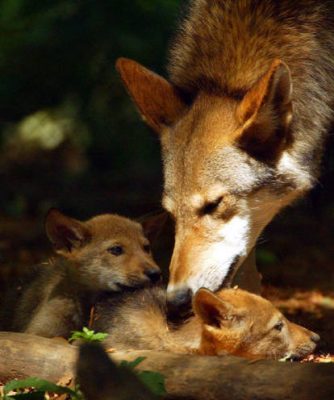In a month filled with news about red wolves, the death of a captive red wolf pup Saturday in Durham perhaps is symbolic of the arc of hope and despair for the fate of the endangered species.

The birth of a litter of three wolf pups at the Durham Museum of Life and Science last week gave an emotional buffer for supporters when a species assessment report issued three days later raised doubts about the continued survival of wild red wolves in their northeastern North Carolina habitat.
Supporter Spotlight
“Even though I know that death is a regular part of this process, and the first month of life is very fragile,” Animal Department director Sherry Samuels wrote on her blog, “it was quite shocking and heartbreaking.”
Although the long-overdue, five-year status review and assessment required under the Endangered Species Act, or ESA, released April 24 by the U.S. Fish and Wildlife Service, recommended that the red wolf remain listed as endangered, its future management is still unknown.
In light of precipitous losses in both the animal’s wild population and their public support, the unchanged status in the review, based on the latest science, is good news for the wolves.
“I try to encourage folks not to over-interpret and be too pessimistic about the prospects for the red wolves,” Pete Benjamin, field supervisor in Fish and Wildlife’s Raleigh office, said in an interview. “I think there are opportunities and hope for the species.”
The number of red wolves roaming the 1.7 million-acre recovery area — public and private land in Hyde, Tyrrell, Washington, Beaufort and Dare counties — has plummeted to about 40 from the population peak in 2006 of about 130.
Supporter Spotlight
Last September, the agency proposed decreasing the wolves’ range to federal land in Dare County, a strategy condemned by some conservationists who contend the restriction would doom the species. The revised Endangered Species Act rule, environmental assessment and proposed management plan are expected to be released for public comment by summer’s end.
“Our job is to try to recover this species,” Benjamin said. “Regardless if we were going to determine to terminate the northeastern North Carolina population – I’m not saying we’re going to do that – that does not mean we are giving up on the red wolf recovery.”
Red wolves had once ranged from Texas and Louisiana to the Ohio River Valley to the Atlantic coast into northern Pennsylvania, but because of habitat loss and predator-control efforts, their population dwindled to only southern Texas and Louisiana.
Listed as endangered in 1967, the red wolf was declared extinct in the wild in 1980. But seven years later, four pairs of captive wolves were transferred from Texas to the Alligator River National Wildlife Refuge in northeastern North Carolina, an area deemed suitable partly because it had no coyotes. In 1995, the agency finalized a rule to manage the “nonessential, experimental population” of captive-bred red wolves in the recovery area.

Innovative and intensive management strategies were developed in the field that were so successful they were used as a model in other wolf conservation programs. Two tactics – sneaking captive-born pups into wild nests, and using sterile coyotes as placeholders to limit encroachment into wolf territory – led to steady increases in red wolves.
But about four years ago, faced with diminished political and public support, the agency scaled back the program. Gunshot deaths started increasing, and wolves lost ground to coyotes. With fewer wolves to mate with, hybridization with coyotes became more of a concern.
A captive-breeding program, which is managed separately, has continued at numerous zoos and wildlife facilities throughout the country, including the one in Durham. There are currently about 200 red wolves in captivity.
Despite release of the recent assessment that mandates continued management to protect the species, the U.S. Fish and Wildlife Service has lapsed on its legal duty to protect the species, said Sierra Weaver, senior attorney for Southern Environmental Law Center, or SELC, in Chapel Hill.

“They are still in violation of that requirement, regardless of releasing the status review,” Weaver said in an interview. “These are management measures that had been used since the 1990s. They had been used successfully. It was when Fish and Wildlife made its changes that that population plummeted.”
On behalf of the nonprofit Red Wolf Coalition, the Defenders of Wildlife and the Animal Welfare Institute, the law center in November 2015 filed a lawsuit in the U.S. District Court for the Eastern District of North Carolina against the agency for violations of the ESA, including authorization of the killing of a breeding female and suspension of reintroduction of captive wolves into the wild population.
The legal complaint also cited the agency’s failure to do the five-year species review required under the ESA. Prior to the just-released review, the last review had been conducted in 2007.
Weaver said that review of legal briefs in the case is expected to be completed in late June, which may be followed by oral arguments to U.S. District Court Judge Terrence Boyle.
In November 2014, the SELC reached a settlement with the North Carolina Wildlife Resources Commission that allowed coyote hunting in the recovery area to resume in daylight hours. Judge Boyle had granted the law center a temporary injunction in May of that year banning coyote hunting because of its detrimental effect on wolves. Four wolves were shot in 2012 shortly after a temporary rule allowed spotlight night hunting of coyotes. Hunting of red wolves is illegal, but they can be mistaken for coyotes, especially at night.
“By designating the red wolf as protected and dedicating funding and efforts for more than 25 years in program to rehabilitate the once nearly-extinct species,” Boyle said in his ruling. “Congress has repeatedly demonstrated that it has chosen to preserve the red wolf – not simply to let inaction determine its fate.”
According to the Wildlife Management Institute, between 1987 and 2014, the program has cost about $30 million.
Gunshot mortality has been a big factor in undermining species recovery. By 2003, 28 wolves had been shot. Between 2004 and 2011, an additional 52 wolves were shot.
After Boyle’s ruling, public sentiment against the red wolf got only worse. One month after the injunction was issued, the Wildlife Commission requested a review of the red wolf reintroduction program. In November 2017, Sen. Thom Tillis, R-N.C., asked Fish and Wildlife to end the red wolf recovery program.
Weaver said the latest status review reinforces the urgency of the need for the agency to resume the previously successful management practices to ensure that the wolves survive in the wild.
“They absolutely have a chance,” she said. “The only thing that’s required here is for the agency to find a backbone (and) recommit to what they know works.”
Benjamin acknowledged that it has been a struggle for the agency to stay on top of the five-year status assessments required for all the endangered species. But despite the delay in the red wolf review, he said, it’s not as if the management issues with the wild population were unknown and unaddressed.

One of the more controversial aspects of red wolf management is an ongoing debate on whether the red wolf is distinct enough as a species to deserve protection. Critics contend that the animals are little more than mutts, “coywolves” that are coyote hybrids.
Last month, Congress directed the agency to work with an independent organization to determine whether the red wolf’s taxonomy represents a separate species.
What complicates matters with canids – dogs, foxes, coyotes, jackals and wolves – is that they interbreed. Whatever the master canid started as, over the centuries its line has split and come back together numerous times.
So just as modern humans, some more than others, have Neanderthal genes, wolves also have complex genetics. The species status assessment details three unsettled hypotheses for the origins of the red wolf: ancient gray wolf-coyote hybrid; recent gray wolf-coyote hybrid; or coyote evolved to divergent lineage. Different studies and different experts have come to different conclusions, or none at all.
“So it’s hard to sort these lineages,” Benjamin said. “By the time anybody got around to studying the red wolves, there were very few of them left. Putting the puzzle back together is very difficult, because we’re missing so many pieces to start with.”
The agency is also studying what other places the red wolves could be re-introduced, Benjamin said, which presents another challenge.
Since the law requires the red wolves to be managed in their historical habitat – the southeastern U.S. – they can’t be relocated to, say, Wyoming. But wolves prefer very rural landscapes with few people and few roads, a hard find in the eastern U.S. Coyotes, meanwhile, have moved into wolf territory as well as suburban neighborhoods.
But Benjamin, a veteran wildlife manager, is not despairing for the wolves’ future, although he recognizes it’s a heavy lift for conservation.
“We know more now than when we did the last five-year review,” Benjamin said. “But people working together can find ways to overcome these challenges in areas where people live and where wolves live.”








